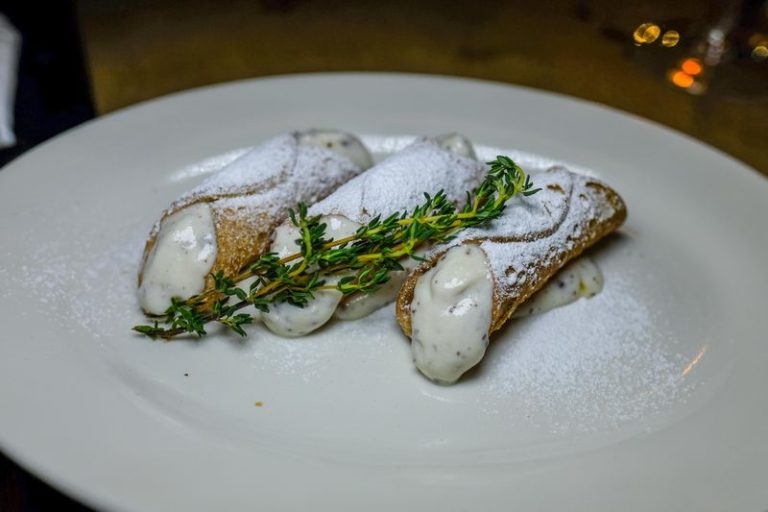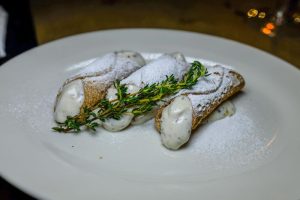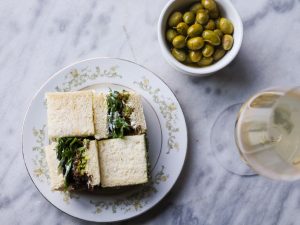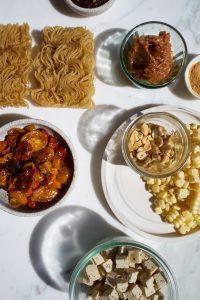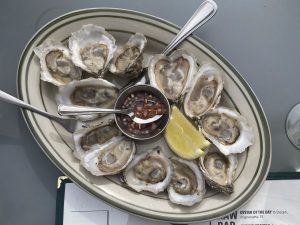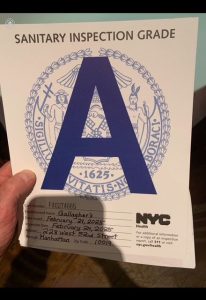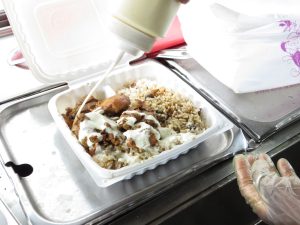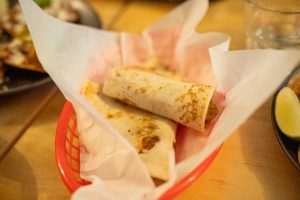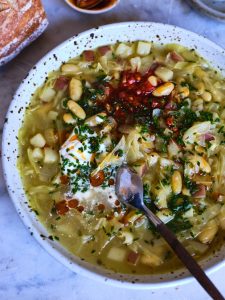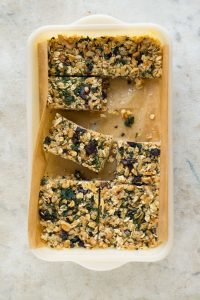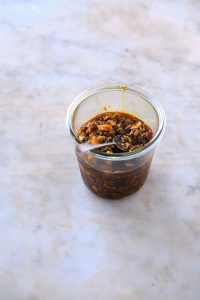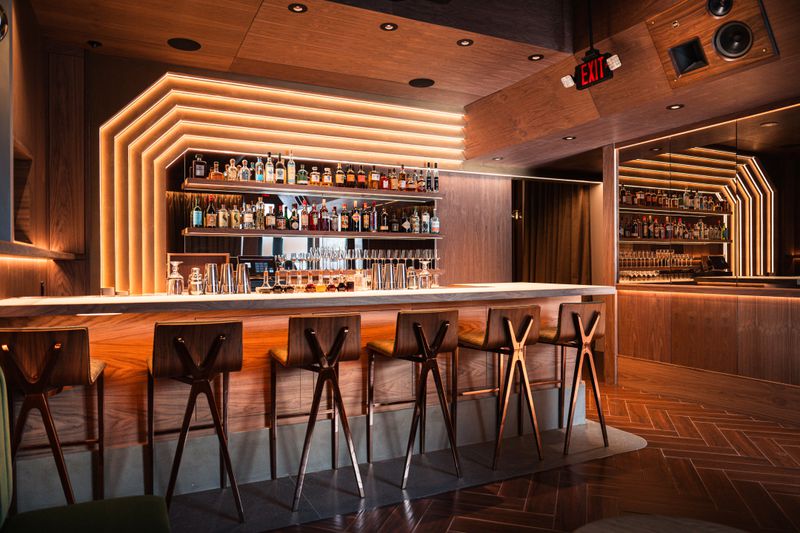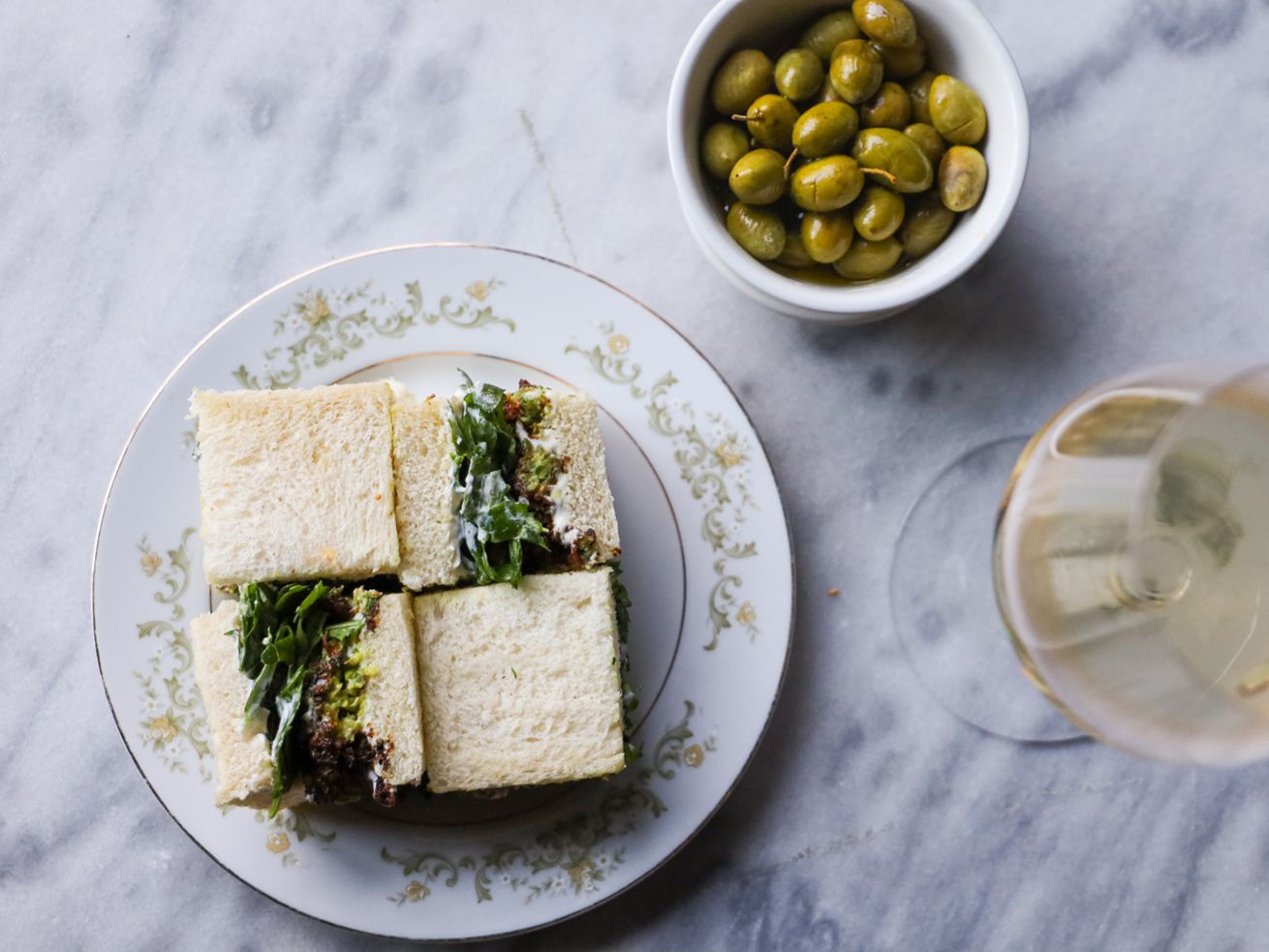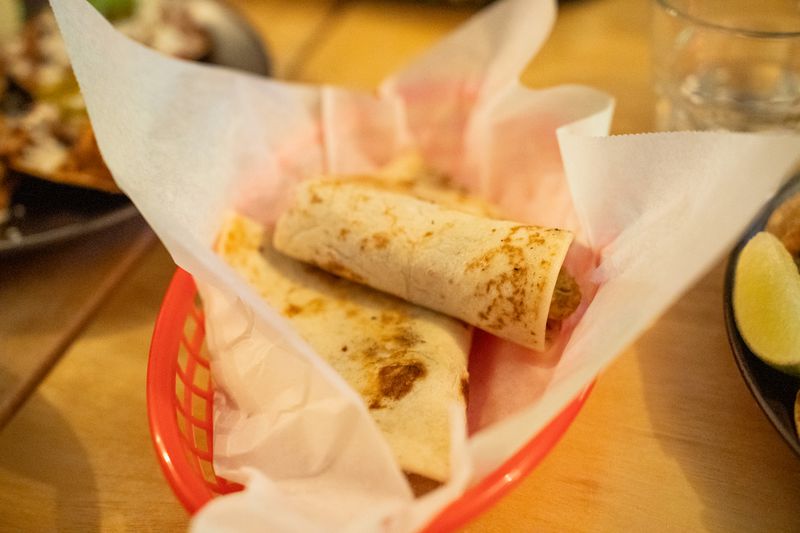
Shukette Alum Opens a Must-Try Honduran Spot in Jersey City
At Perquín, a recently opened Honduran-leaning restaurant, messy eating is the point. Their pork tostadas and shrimp tacos arrive with utensils but will likely go untouched. Finger-licking sauces, from herby aji verde to creamy salsa blanca, invite diners to dive in. Just above the bathroom sink, fuzzy spray-painted script jests: “Aren’t you glad that you ate with your hands?”
It’s become a neighborhood favorite since opening in November at 85 Morris Street in Paulus Hook, Jersey City. Amongst New York City residents, however, the restaurant has flown under the radar — even though it is just a 15-minute commute to the World Trade Center. Owner Bryan Girón, 29, has long worked in restaurants: an alum of Barbuto, Bread & Salt, Tao Hospitality, and Shukette, where he was most recently chef de cuisine.
Honduran food is the primary draw at Perquín, although the kitchen has influence from Ecuador, Mexico, and greater Central America. The restaurant’s handwritten blackboard menu, which changes frequently, features snacks, traditional street food (playfully called chucos or “messy”), entrees starring masa, and a rotating dessert. Every day, the kitchen debuts a new special and there’s an option for a pre-fixed menu. The restaurant has also introduced a chef’s table in view of the kitchen. It is the only table that requires reservations and allows him to approximate the price of a check while also getting to experiment freely.
Still, the atmosphere remains deliberately casual. Two TVs above the bar broadcast the latest sports news. “[In New York] you have to wait months, sometimes, to eat somewhere,” Girón says. “I wanted Perquín to be approachable, accessible, and not so stuffy.”
 Jess Eng/Eater NY
Jess Eng/Eater NY

Perquín’s most popular dish is pollo chuco, a plate of fried chicken smothered in tomato salsa and salsa blanca, perched atop a thin bed of lightly fried green bananas. (It’s also gluten-free.) Then there’s salchipapa, a saucy basket of french fries, chorizo, nduja, and American wagyu hot dogs with a generous drizzle of herby aji verde. The most unexpected hit, according to Girón, has been the baleada, a traditional Honduran dish eaten around the clock, but hard to find outside the country. Neither taco nor quesadilla, their version comes with refried beans, plantains, sumac, and onions, all stuffed into a pillowy flour tortilla. “We have two guys who are incredible at making the baleada. No one can stretch the dough like that,” he says.
Despite the growing coalition of Mexican and Latin restaurants in the city, Honduran food still has a relatively small footprint. At first blush, the cuisine seems quite similar in ingredients and flavors to those of neighboring countries. “We all eat pretty much the same,” Girón admits. “It’s very rice and bean heavy yucca, plantains, tortillas. Braised meats, grilled meats, a lot of fruit.” But peel back and differences become starker:In Northern Honduras, for instance, an indigenous Black community known as Garifuna specializes in dishes that primarily use coconut, seafood, and cassava.
Girón isn’t trying to reinvent the wheel, but he’s ditching purist attitudes by leaning into his professional background in Italian and Middle Eastern cooking. Many components are made in-house: spice blends, aiolis, french fries, pickles, vinaigrettes, crema, cheese, and homemade syrups for the bar. Even the chicken skins from chullos are transformed into chicharrón specials. Sometimes, the only tweak is a fistful of herbs, a nod to Shukette.
“I’m applying everything that I’ve learned to what I know about Latin food and creating my own style,” he says. “I want to change the image of what Latin food could be.”
Girón’s decision to open his first restaurant in Jersey City feels like an inevitable homecoming. His family moved to Bayonne, New Jersey when he was eight, but he would spend his entire summer in Tegucigalpa. Month-long trips meant reuniting with his grandmother, who taught him how to pick produce at the local market, haggle for goods, and nurture a pot of red beans over a fire pit. Back in Jersey, Girón would frequently ask his dad to make potaje, a savory yellow lentil soup flavored with pork and red sofrito that tasted just like he remembered from Honduras. Today, it’s on Perquín’s menu.
When it came to opening, he lacked the money for PR or a design firm for the buildout, so he took measures into his own hands. He gutted the red booths left over from a French bistro and mocked up visuals modeled after Honduras’s national landmarks. The space now has vibrant murals hand brushed by his childhood friend-turned-graffiti-artist Mr. Emagin.
The opening hasn’t been without its hurdles. Jersey is a notoriously difficult place to obtain a liquor license, especially when compared to New York City, and the cost came out to around $400,000, according to Girón.
But they make good use of it. Girón recruited J.P. Torres, another Jersey resident, to oversee a lime-inflected list of cocktails and drinks, including wine, beer, and NA options. There are classics like pisco sours and margaritas but also unconventional options. The dessert menu features homemade coquito shots for $5, a recipe that Girón perfected over the years.
Still, a neighborhood restaurant is only as good as its satisfied customers. “Perquin is so different from anything else in the area and feels refreshing and new,” says Rory Carrillo, a born and bred Jersey City resident. Madhurima Chakraborty, another neighbor and food blogger agreed: “The service was very intimate and [took] extra care to elaborate and suggest dishes.”
Others, such as Bayonne resident Denzyl Amankwah, believe Perquín will thrive in the neighborhood, specifically. “It’s a very bold move to change a menu daily, but I think that kind of ambitious culinary experience is going to pay off tremendously in Jersey City.”

At Perquín, Honduran food melds with Bryan Girón’s experience working in Manhattan restaurants
At Perquín, a recently opened Honduran-leaning restaurant, messy eating is the point. Their pork tostadas and shrimp tacos arrive with utensils but will likely go untouched. Finger-licking sauces, from herby aji verde to creamy salsa blanca, invite diners to dive in. Just above the bathroom sink, fuzzy spray-painted script jests: “Aren’t you glad that you ate with your hands?”
It’s become a neighborhood favorite since opening in November at 85 Morris Street in Paulus Hook, Jersey City. Amongst New York City residents, however, the restaurant has flown under the radar — even though it is just a 15-minute commute to the World Trade Center. Owner Bryan Girón, 29, has long worked in restaurants: an alum of Barbuto, Bread & Salt, Tao Hospitality, and Shukette, where he was most recently chef de cuisine.
Honduran food is the primary draw at Perquín, although the kitchen has influence from Ecuador, Mexico, and greater Central America. The restaurant’s handwritten blackboard menu, which changes frequently, features snacks, traditional street food (playfully called chucos or “messy”), entrees starring masa, and a rotating dessert. Every day, the kitchen debuts a new special and there’s an option for a pre-fixed menu. The restaurant has also introduced a chef’s table in view of the kitchen. It is the only table that requires reservations and allows him to approximate the price of a check while also getting to experiment freely.
Still, the atmosphere remains deliberately casual. Two TVs above the bar broadcast the latest sports news. “[In New York] you have to wait months, sometimes, to eat somewhere,” Girón says. “I wanted Perquín to be approachable, accessible, and not so stuffy.”

Jess Eng/Eater NY

Jess Eng/Eater NY
Perquín’s most popular dish is pollo chuco, a plate of fried chicken smothered in tomato salsa and salsa blanca, perched atop a thin bed of lightly fried green bananas. (It’s also gluten-free.) Then there’s salchipapa, a saucy basket of french fries, chorizo, nduja, and American wagyu hot dogs with a generous drizzle of herby aji verde. The most unexpected hit, according to Girón, has been the baleada, a traditional Honduran dish eaten around the clock, but hard to find outside the country. Neither taco nor quesadilla, their version comes with refried beans, plantains, sumac, and onions, all stuffed into a pillowy flour tortilla. “We have two guys who are incredible at making the baleada. No one can stretch the dough like that,” he says.
Despite the growing coalition of Mexican and Latin restaurants in the city, Honduran food still has a relatively small footprint. At first blush, the cuisine seems quite similar in ingredients and flavors to those of neighboring countries. “We all eat pretty much the same,” Girón admits. “It’s very rice and bean heavy yucca, plantains, tortillas. Braised meats, grilled meats, a lot of fruit.” But peel back and differences become starker: In Northern Honduras, for instance, an indigenous Black community known as Garifuna specializes in dishes that primarily use coconut, seafood, and cassava.
Girón isn’t trying to reinvent the wheel, but he’s ditching purist attitudes by leaning into his professional background in Italian and Middle Eastern cooking. Many components are made in-house: spice blends, aiolis, french fries, pickles, vinaigrettes, crema, cheese, and homemade syrups for the bar. Even the chicken skins from chullos are transformed into chicharrón specials. Sometimes, the only tweak is a fistful of herbs, a nod to Shukette.
“I’m applying everything that I’ve learned to what I know about Latin food and creating my own style,” he says. “I want to change the image of what Latin food could be.”
Girón’s decision to open his first restaurant in Jersey City feels like an inevitable homecoming. His family moved to Bayonne, New Jersey when he was eight, but he would spend his entire summer in Tegucigalpa. Month-long trips meant reuniting with his grandmother, who taught him how to pick produce at the local market, haggle for goods, and nurture a pot of red beans over a fire pit. Back in Jersey, Girón would frequently ask his dad to make potaje, a savory yellow lentil soup flavored with pork and red sofrito that tasted just like he remembered from Honduras. Today, it’s on Perquín’s menu.
When it came to opening, he lacked the money for PR or a design firm for the buildout, so he took measures into his own hands. He gutted the red booths left over from a French bistro and mocked up visuals modeled after Honduras’s national landmarks. The space now has vibrant murals hand brushed by his childhood friend-turned-graffiti-artist Mr. Emagin.
The opening hasn’t been without its hurdles. Jersey is a notoriously difficult place to obtain a liquor license, especially when compared to New York City, and the cost came out to around $400,000, according to Girón.
But they make good use of it. Girón recruited J.P. Torres, another Jersey resident, to oversee a lime-inflected list of cocktails and drinks, including wine, beer, and NA options. There are classics like pisco sours and margaritas but also unconventional options. The dessert menu features homemade coquito shots for $5, a recipe that Girón perfected over the years.
Still, a neighborhood restaurant is only as good as its satisfied customers. “Perquin is so different from anything else in the area and feels refreshing and new,” says Rory Carrillo, a born and bred Jersey City resident. Madhurima Chakraborty, another neighbor and food blogger agreed: “The service was very intimate and [took] extra care to elaborate and suggest dishes.”
Others, such as Bayonne resident Denzyl Amankwah, believe Perquín will thrive in the neighborhood, specifically. “It’s a very bold move to change a menu daily, but I think that kind of ambitious culinary experience is going to pay off tremendously in Jersey City.”


